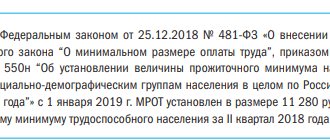Sometimes employers consider it necessary to pay their employees additional funds in addition to their salaries in order to reward them for good work or to compensate them in some way. The very name of the bonus indicates that it is not assigned to everyone, but only to specific employees based on certain indicators.
Let us clarify on what basis a personal allowance can be established, which categories of workers are not entitled to it at all, how to properly formalize it, and, if necessary, cancel it.
How to set a personal allowance for an employee ?
The essence of a personal allowance
An employee can receive not only a “bare” salary, but also additional payments, including those assigned in addition to wages.
The Labor Code does not have a precise definition of a bonus. The bonus included in the salary, reflected in the employment contract or additional agreement to it, is common to all personnel when certain conditions occur, for example, for work in certain climatic zones, for shift work, etc. Such bonuses are not considered personal.
If the employer is not obliged to assign a bonus, but he does it for individual employees on an individual basis, reflecting the conditions of the appointment in a special Regulation, collective agreement or other local act, such payment will be a personal bonus . The right to assign such payments by the employer is granted by Art. 135 Labor Code of the Russian Federation.
The feasibility of assigning personal allowances
In what cases may an employer need a personal allowance mechanism? When might it be necessary to make remuneration special for a specific employee or group of employees? The following options are possible:
- the employer wants to highlight the successes of a particular employee;
- there is a desire to reward an employee for having outstanding or unique knowledge and skills;
- It is undesirable to change the existing system of rates and salaries, but at the same time there is a need for additional incentives for workers.
Question: When calculating vacation pay, should I take into account the bonus paid to the employee by March 8, the personal bonus to the salary and the one-time charge for mentoring? View answer
Different types of personal allowances
The type of allowance can be determined by various factors:
- Basis for accrual - the employer has the right to assign a personal allowance:
- for experience;
- for skill level;
- for a certain intensity of work;
- for professional excellence;
- for performing tasks of special importance and/or urgency;
- for “bonus” skills and abilities, for example, knowledge of a foreign language;
- for an academic degree in a specialized field;
- for work under conditions of official secrecy, etc.
- Duration of validity of the provisions on the allowance - these payments can be established either permanently or temporarily:
- for a month;
- per quarter;
- for a year;
- indefinitely.
- The amount of the premium can be determined in different ways:
- a fixed amount is fixed in local documents;
- the amount of the bonus is calculated in a certain way, for example, as a percentage of the salary or average salary;
- determination of the size by the labor participation rate: the monthly amount allocated for allowances will be distributed differently within the group of workers.
NOTE! Despite the fact that the amount for personal allowances is not limited by law, they should not be set in an amount exceeding the monthly salary. Large premiums are difficult to justify in court in the event of any disputes; there is a high probability that they will be recognized as part of mandatory payments. Practice shows that the maximum amount of a personal bonus should not be more than 50% of the salary, and the optimal amount is 10-20%.
Who gets a personal allowance and who doesn’t?
Additional personal benefits can be assigned to any full-time employee of the organization, since they are added to his salary, often calculated as a percentage of his salary. At the same time, the registration of an employee on the staff does not have much significance; the following may qualify for a personal allowance:
- an employee who has entered into a regular employment contract;
- "conscript";
- part-time worker.
It is not customary to assign personal bonus payments to the following categories of workers:
- freelancers;
- workers working under a contract;
- who have concluded civil contracts.
Additional payment for combining professions and performing the duties of temporarily absent employees
With the consent of the employee, he can be recruited to work in another specialty while maintaining his main job responsibilities (combining professions or positions) or entrust him with the work of a temporarily absent employee.
In these cases, you are required to provide the employee with additional payment.
The amount of the additional payment and the procedure for determining it are established by agreement of the parties to the employment contract (employee and employer).
Additional payment is calculated based on the order of the manager. The order indicates the position for which the employee will perform the work, the volume and timing of the work performed, and the amount of additional payment.
The procedure for calculating additional payments for combining professions and performing work for a temporarily absent employee depends on the form of remuneration:
- time-based;
- piecework.
Calculation of additional payments for time-based wages
In the case of time-based wages, by agreement between the employee and the employer, additional payment may be established:
- in a fixed amount (for example, 1000 rubles);
- as a percentage of the employee’s hourly (daily) rate or salary;
- as a percentage of the hourly (daily) rate or salary for the profession (position) that the employee combines (when combining professions);
- as a percentage of the hourly (daily) rate or salary of the absent employee.
Registration of a personal allowance
IMPORTANT! A sample order for establishing a personal allowance from ConsultantPlus is available here
The employer is not obliged to include the terms of the personal bonus in the employment contract, since this is an incentive payment. But since this is still part of the remuneration, it must be documented.
To do this, you need to regulate the personal bonus in a collective agreement or in the Regulations on remuneration and be sure to refer to this document in the text of the employment agreement (Article 57 of the Labor Code of the Russian Federation).
IMPORTANT! If the employer does not include provisions on the bonus in local documents, paying it without registration, he is not threatened with legislative liability. The only thing that can serve as a disadvantage for the employer in such a situation is that unreasonable payments cannot be attributed to expenses that reduce the tax base.
Petition and order for personal allowance
How else can you arrange the payment of a personal allowance, if not through a separate document? This may be necessary when the nature of the payments is not systematic, but one-time or calculated for a certain period. In this case, it is advisable to draw up a memo (petition) from immediate management to a higher one who has the authority to assign a bonus. This could be the general director, financial director, head of the personnel department, chief accountant, etc. In the text of the note, in addition to the mandatory details of business documents, you should indicate:
- arguments justifying the assignment of a bonus to a specific employee or their group;
- the expected amount of additional payment;
- at what expense is the premium supposed to be assigned (for example, from the wage fund or by increasing profits from sales, etc.);
- validity period of additional payments.
ATTENTION! It is not customary to formalize permanent allowances using memos. After the expiration of the specified period, you can again apply for a supplement. With this kind of document you can request the appointment, increase, decrease, extension or cancellation of a personal payment.
The compiled memo, signed by management, will become the basis for preparing an order for the calculation of the allowance. The execution of this order can be in any form. It is important to correctly motivate the appointment of additional payments, since their feasibility from a production or economic point of view is a guarantee that these costs are included in the cost of production, which is very strictly checked by tax authorities.
After issuing an order to assign an allowance, the employee must be familiar with it, which is confirmed by a personal visa (this procedure is common for any orders).
Additional pay for working overtime
The employer may involve employees (with their written consent) to work overtime.
Overtime is time worked outside the established working hours.
So, if your organization’s schedule provides for an eight-hour working day, then overtime is considered time worked in excess of eight hours.
If an employee, based on the manager’s order, works more time than he is scheduled to do, you are required to pay him extra for overtime work.
Even if the order for overtime work is not properly executed, but there was an oral order from the manager, work outside working hours is overtime work and is paid at an increased rate (Letter of the Ministry of Labor of Russia dated March 5, 2022 No. 14-2/B-149).
It should be remembered that if an employee has irregular working hours and worked overtime without an order from the manager, no additional payment is accrued.
At the same time, an exhaustive list of cases when employees can be involved in overtime work is established by Article 99 of the Labor Code.
With the written consent of the employee, you can be required to work overtime in the following cases:
- if you need to complete work, which, if not completed, may cause harm to the organization’s property (property of third parties) or people’s health;
- during temporary work on the repair and restoration of mechanisms or structures in cases where their malfunction may cause the cessation of work for a large number of workers;
- to continue work if the replacement employee fails to appear, if the work does not allow a break.
Without the consent of an employee, you can be required to work overtime in the following cases:
- when working to eliminate the consequences of a catastrophe, industrial accident or natural disaster, as well as to prevent them;
- during socially necessary work to eliminate unforeseen disruptions to the normal operation of water and gas supply systems, heating, lighting, sewerage, transport, communications;
- during work the need for which is caused by a state of emergency or martial law;
- during urgent work under emergency circumstances, as well as in other cases that threaten the life or normal living conditions of the entire population or part of it.
In other cases, overtime work is permitted with the written consent of the employee and taking into account the opinion of the representative body of employees.
note
Overtime work for each employee should not exceed four hours for two days in a row and 120 hours per year (Article 99 of the Labor Code of the Russian Federation). These restrictions do not apply to work on weekends and holidays, since Article 113 of the Labor Code does not establish duration restrictions for work on weekends and holidays.
The following are not allowed to work overtime:
- workers under 18 years of age;
- other categories of workers in accordance with federal laws.
Involvement of disabled people and women with children under three years of age in overtime work is permitted with their written consent and provided that such work is not prohibited for them for health reasons in accordance with a medical report. These employees must be informed in writing of their right to refuse overtime.
Overtime pay
Overtime work is paid at an increased rate. Article 152 of the Labor Code establishes that the first two hours of overtime work are paid at least one and a half times the rate, subsequent hours - at least double. Specific sizes can be determined by a collective agreement, an employment contract, or local regulations.
At the request of the employee, overtime work, instead of increased pay, can be compensated by providing additional rest time, but not less than the time worked overtime.
Federal Law No. 125-FZ of June 18, 2022 amended Article 152 of the Labor Code. Thus, it is clarified that when determining the duration of overtime work, work performed in excess of the standard working time on weekends and non-working holidays, already paid at an increased rate or compensated by a day of rest (Part 3 of Article 152 of the Labor Code of the Russian Federation) is not taken into account.
Employees are required to work overtime on the basis of an order from the head of the organization. The order indicates the reason and time of overtime work, the workers who perform it, and the amount of additional payment for overtime work.
The procedure for calculating additional pay for overtime work depends on the form of remuneration:
- time-based;
- piecework.
Calculation of additional payments for time-based wages
With time-based wages, employees' wages can be calculated based on:
- from the hourly rate;
- from the daily rate;
- from the monthly salary.
If an employee of your organization has an hourly rate, the amount of additional payment is calculated as follows:
| Additional payment amount | = | Number of hours worked overtime | × | Employee hourly rate | × | Coefficient of surcharge |
The surcharge coefficient for the first two hours of overtime work must be no less than 1.5, and for subsequent hours – no less than 2.0 (Article 152 of the Labor Code of the Russian Federation).
Your organization may set higher copayment rates. The specific sizes of the coefficients are determined in the collective or labor agreement.
If an employee of your organization has a daily rate, then the hourly rate required to determine the amount of additional payment is calculated as follows:
| Hourly rate | = | Daily rate | : | Number of working hours per day |
If an employee of your organization has a monthly salary, then the hourly rate required to determine the amount of additional payment is calculated as follows:
| Hourly rate | = | Monthly salary | : | Number of working hours per month |
Obviously, with this calculation option, when setting the tariff rate for a month, the hourly rate and surcharge for overtime work in one month may turn out to be more or less than the hourly rate and surcharge in another month. Therefore, officials of the Russian Ministry of Health issued letter No. 16-4/2059436 dated July 2, 2014, which can be used by organizations in other industries, since Article 152 of the Labor Code does not establish a procedure for determining the minimum one and a half and double amount of overtime pay.
Officials advise calculating the hourly tariff rate by dividing the employee's salary by the average monthly number of working hours, depending on the established length of the working week in hours. In this case, the average monthly number of working hours is calculated by dividing the annual norm of working time in hours by 12. This procedure for calculating part of the salary per hour of work to pay for overtime work (as well as at night or on non-working holidays) allows for an equal number of hours worked in different months, receive the same payment.
The procedure for calculating the hourly tariff rate from the established monthly one must be fixed in a collective agreement, agreement or local regulation.
Calculation of additional payments for piecework wages
When paying piecework, the procedure for calculating additional payments is established in the collective (individual) employment contract.
The agreement may provide:
- payment for overtime hours at an increased rate (without taking into account the quantity of manufactured products and piece rates);
- additional payment is calculated based on a coefficient of 0.5 (for the first two hours of overtime work) and 1.0 (for subsequent hours of overtime work) of the hourly tariff rate.
The employee's hourly wage rate is established in the staffing table.
Important nuances of personal increases
It is important to regulate all financial issues correctly and take into account all legislative subtleties. When assigning personal increases, the employer must take into account certain circumstances:
- A correctly executed personal allowance in accounting is treated as “labor expenses”.
- The bonus is calculated simultaneously with the salary.
- This payment is included in the calculation of average earnings necessary for calculating, for example, vacation pay (Resolution of the Government of the Russian Federation No. 922 of December 24, 2007, as amended on October 15, 2014).
- If the deadline specified in the bonus regulations is violated, when the payment is unreasonably and unexpectedly terminated earlier for the employee, the employee has the right to demand additional accrual of the bonus and payment of late fees.
- If the head of a structural unit does not send a memo on time, personal payments will be stopped, because this document is the basis for issuing an order to accrue funds.
- If an employee receiving a personal allowance is transferred to another position, the right to the allowance is not retained unless it is provided for by the provisions of the new position.
- A change in the leadership of an organization may lead to changes in the provisions on personal allowances.
- A personal allowance must be reflected in the staffing table, indicating the numbers of orders for its accrual.
Payout Features
The specifics of calculating and assigning additional payments and allowances are specified in legislative and local regulations. Using several examples, we can consider the specifics of this procedure.
Maternity leave calculation
Determined on the basis of Federal Law-81 “On state benefits for citizens with children,” adopted back in 1995, and by-laws. For the calculation, the average earnings for the two previous years are taken (personal income tax is not deducted). However, there is a limit on the amount that income must not exceed. A working woman has the right to receive benefits for the specified period, amounting to 100% of the result received. Experience doesn't matter.
In less than a month
Income is determined in proportion to the time worked, which is quite logical and follows from the interpretation of labor law norms. With a piece-rate system, calculations are greatly simplified, because income directly depends on the completed quota. If a day or shift worked is taken as a basis, then the number of such days or shifts must be multiplied by the established rate.









